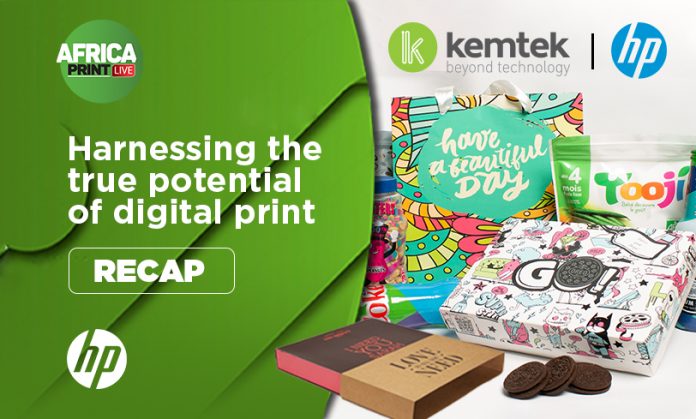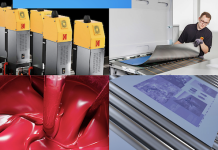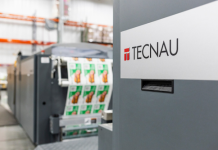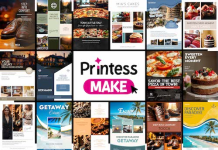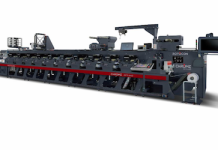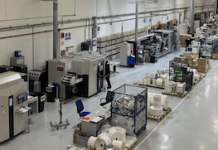Kemtek Imaging Systems’ and HP Indigo’s webinar focused on the true flexibility of digital print to not only provide the best solution for on-demand printing, but how it can be used as a platform for significant profitable growth through the power of personalisation, customisation and decoration.
Paul Regan, director of award-winning UK creative design and print house, F.E. Burman, in London, discussed how he and his team made the unlikely choice to increase their turnover during the recent ‘lockdown’ months by using the power of customisation and personalisation. The session was moderated by Wendy McLoughlin, HP Indigo Business Development Manager, Kemtek Imaging Systems.
Clearly the last six months have been challenging for a lot of businesses, have there been any positives for F.E. Burman?
Basically, we have stayed open. We’ve been involved with the health services, as well as poster projects to enable creatives at home to express how they are feeling. Many printers have closed in London – little shops with poor quality printers – but we have attracted more clients during this time.
Living in a world of volatility, uncertainty, complexity and ambiguity, how did you leverage digital print to support business growth?
There are many people that still want to print materials that are not for an event or that are not urgent. People have had time to finish books or change their branding, so they come to companies that have the best printing equipment and can bring their ideas to life.
How did F.E. Burman move from a panic/survival headspace to an innovative and profit making focus? In fact, F.E. Burman retained their turnover during the lockdown months.
We reduced staff, through the furlough system in the UK. The property market strangely went up, which ties in to web-to-print solutions. We had other projects too. Graphic colleges shut down, so we created a project where you could order posters, drop the file in, and that gave students something physical to hold. Another was a magazine called Flora. The editor encouraged people to take photographs of their gardens and create their own wrapping paper. We also printed ‘In isolation the first wave’, a typo/graphic journal documenting the first 100 days of social distancing in the UK, pictured below.
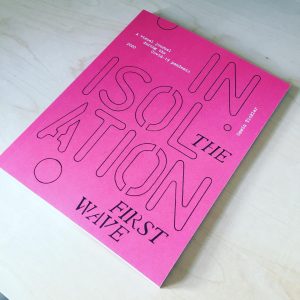

Is it imperative to have a creative team in-house or do you only collaborate with agencies and brand owners directly?
It is important to have a creative within the sales team, but we collaborate with everyone. When someone spends three months creating an artwork, suddenly it is not about the price, but what the person has done. Printers have to get closer to designers. Two or three hundred years ago, if you were a printer, you were seen as a key player in the community. We have got to bring that back.
What is a good approach you use when trying to embark on a new project or customer?
It is about knowing that there are many things we haven’t done, and that nobody has done. We work closely with the paper companies, so we have teams of people who are our partners (for references). Also, start loving print again. I am not a creative, but I am surrounded by so many creative people – always push that uniqueness.
How do you sell digital?
You need nice materials and designs, and if you don’t respect those then you don’t have a good product. It is about utilising paper better – simplicity is key. White ink has enabled us to print on any paper we like, while silver inks give us metallic effects. A lot of our ideas are also not possible without creative people.
Freedom of creativity is integral to the success of F.E. Burman – do you allow customers/students/agencies access to your office/print shop?
Big brands like it when they know you have got students. I say let the students share their ideas. We always see students walking out of our business saying they love print even more. Make sure your press has many options and that you use all of them. A press can be a very creative ‘magic box’ – you need to allow people to come in and play with it.
F.E. Burman have embraced digital print for over 26 years, what has happened over the last two years that has made a massive difference?
For the last two years it has been about us believing in ourselves. We have seen many people wanting to buy something that nobody else is doing, and people becoming very creative with print.
It is about being known as the company with the technology, but it is mostly about listening to clients. We have also needed to be able to foil, and we have an in-house team for this.
Has the drive for web-to-print escalated during this time?
It has definitely increased. We have had time to create web-to-print solutions that have value and are unique.
Any advice for sales functions trying to drive print in the current environment?
Get closer to your clients. Go out to creative clients, especially those working from home, and involve young, creative minds.
What will you do post-pandemic?
Be more open with our competitors, work with the end users and invite our clients to see what we can do.
Do you have advice for an offset printer who is nervous to take the next step?
Try convince offset printers to merge that technology with digital, and by that, they can justify buying an Indigo. An Indigo allows you to do work you have never done before. With offset, you always offer the same applications, with an Indigo, you always have something different.
Watch the full webinar below:
[sc name=”subscribe-socialmedia” ]
[sc name=”submit-newsvideos” ]
KEMTEK IMAGING SYSTEMS
+27116248000
kemtek@kemtek.co.za
http://www.kemtek.co.za


